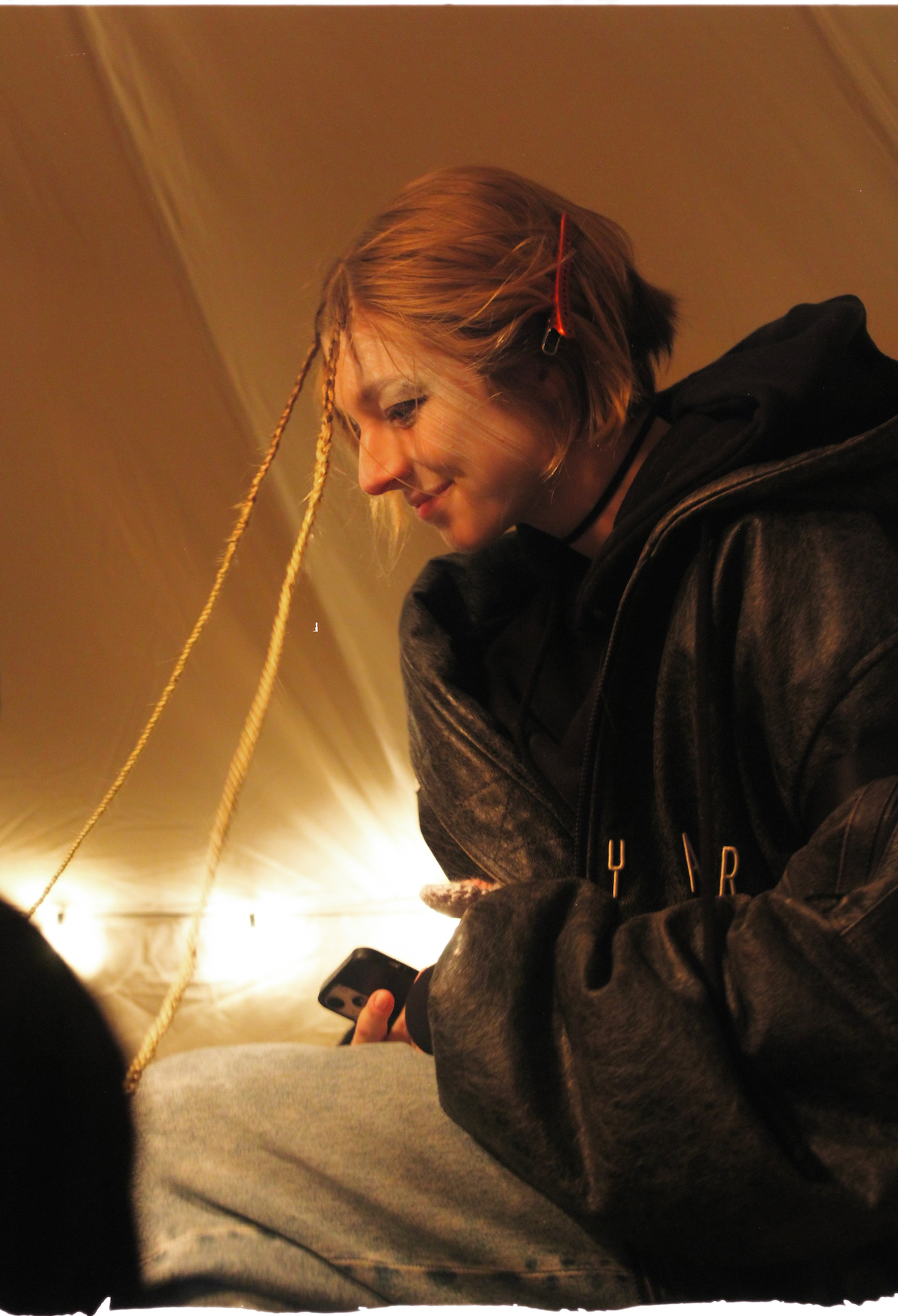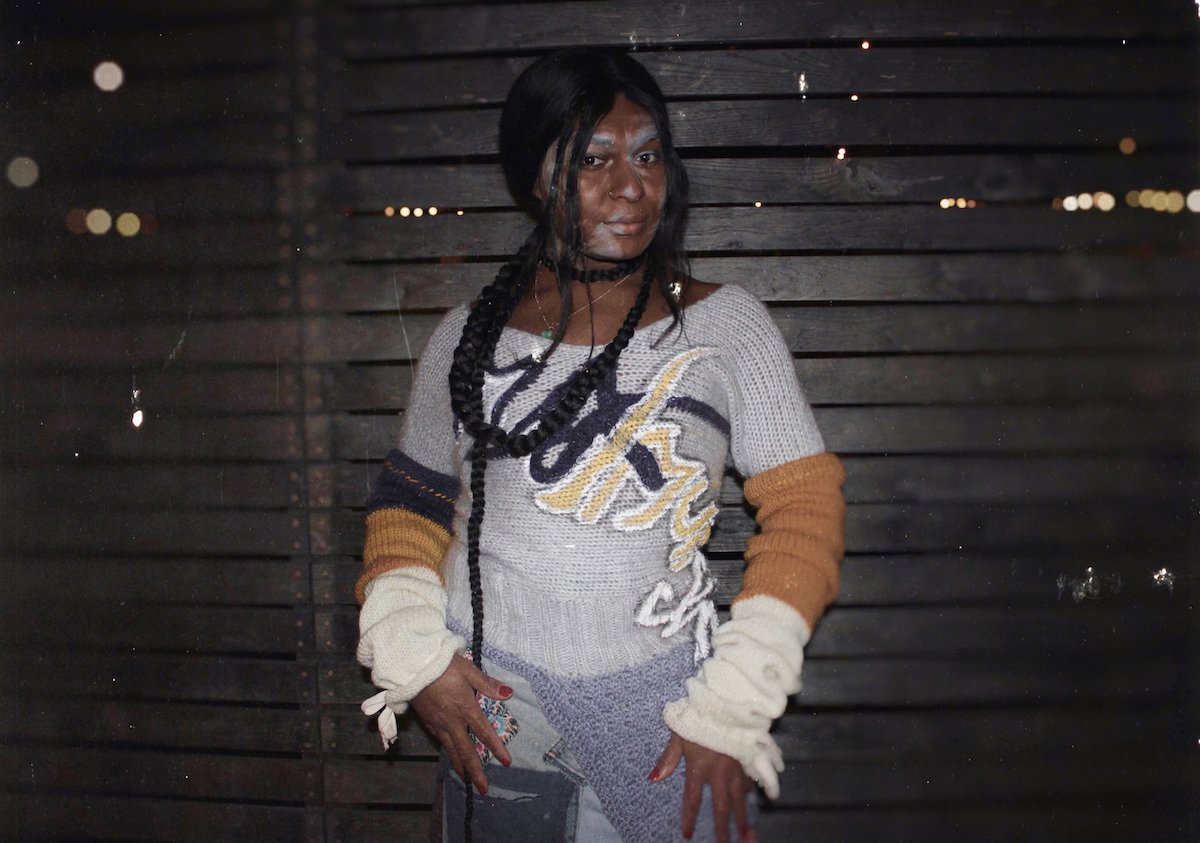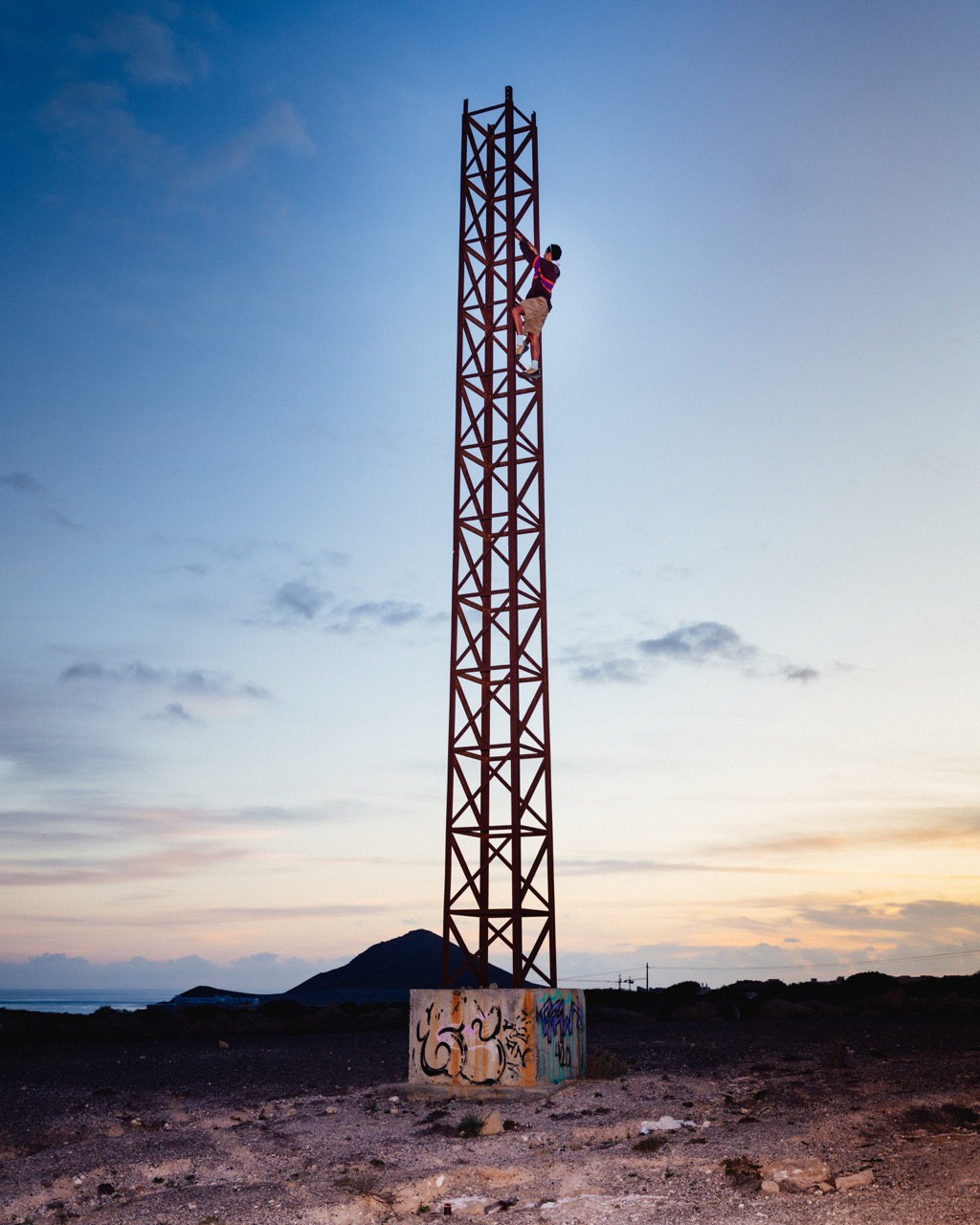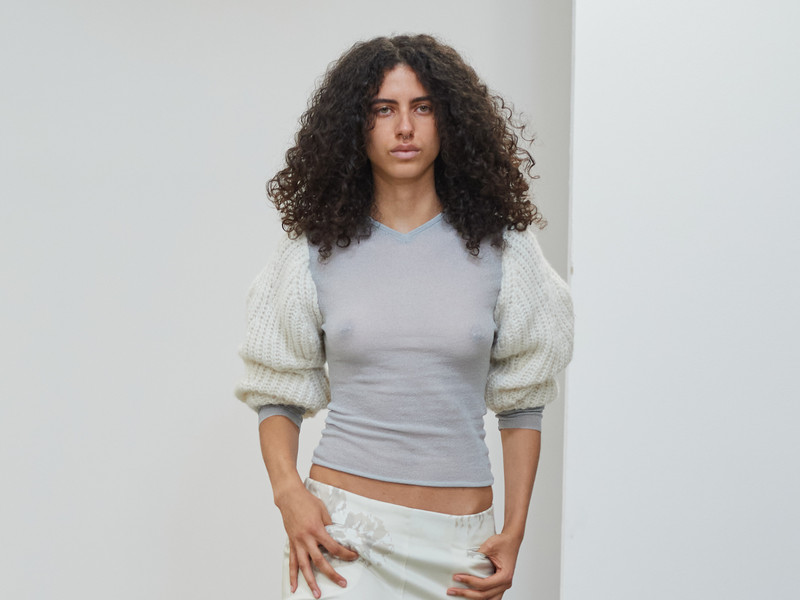Gogo Graham AW22: Touching in the Absence of Touch
Graham creates a sense of timelessness–drawing a thread between her own cultural history and the current moment under the COVID19 pandemic, referencing airstrikes with string lights and contextualizing the magic, and ineffable experience of a child chasing fireflies.
Models shuffled, swayed, and skulked down the dirt runway to Serena Jara’s hypnotic mix re-imagining the film’s title song “Home, Sweet, Home” creating a sonorous sense of silence. Each model holding a sense of longing knotted into the long braids that left faint prints in their path, or clinging to the dolls and props referencing the film.
Nods to the film imbued in each piece as well—made from traditional Japanese yukatas–each look gave structure to the natural shape of the body, rather than forcing the wearer to be molded to it. The collection played with ethereal, yet wearable textures and basics.
The show was touching in the absence of touch. Attendees held themselves close, rubbing goosebumps from their arms, whether brought on by awe or the night's biting air. Graham’s collection teased tenderness, pulling to the surface a feeling of embrace as if closeness were a phantom limb.
Continue reading for an exclusive interview with Gogo and an insider look from Denny.
Cassie Jekanoski— Hi, Gogo. It's a pleasure to meet you. How are you doing today? How have things been unwinding since this show?
Gogo Graham— I'm okay. I'm still you know, kind of in recovery mode and pretty tired. Getting back into the swing of everything else. I feel like this past week/month have been really crazy.
CJ— How have you prepared for this show versus ones previous?
GG— I would say that it's pretty similar as the previous ones. I'm kind of trying to do fittings, and finishing looks. Trying to communicate with models, everyone involved with the production.
CJ— You did so much with the show, like you casted it, styled, all of that sort of stuff. So when you're doing all of that it's much more all-encompassing. Can you talk to me about sort of how it was like working with the people that you casted?
GG— I prefer to cast and style myself, like everything myself. I design based on who I have, for the most part. So I try to make looks that kind of compliment the person wearing it. I feel like with styling, I think if you can't style as a designer, what are you? I think it's something that every designer should be doing.
CJ— Was there anyone this season that you were particularly excited about working with?
GG— I mean, I'm always excited. I don't prefer one over the other, you know.
CJ— What was sort of the inspiration behind this collection? I know you kind of talked about the people but was there anything else on a deeper level?
GG— I would say that with every collection this one was influenced by my state of mind while creating it. And just some of the themes that were coming up a lot were like being at home and comfortable and cozy, and also isolation and depression.
CJ— Would you sort of say that this collection was sort of your outlet for those times when you're feeling isolated and depressed?
GG— I don't know. I have to work, so I had to do something. And I would say that work is an outlet.
CJ— Was there a specific look that really drew the collection together?
GG— I guess I tried to make everything pretty cohesive. I always use recycled materials and I used a lot of blankets and bedding and just reused, comfy t-shirts, knits, and sweatshirts. It was kind of a lot of home goods that I upcycled into garments. I was trying to go along with the comfort thing. I was making these stuffed animal accessories that were made of blankets and stuff so hopefully all that formed a cohesive idea.
CJ— I especially liked the little stuffed animal accessories. I thought they were super cute and very fun. And I feel like it was kind of a good dichotomy between the playfulness of the stuffed animals versus your feelings of the isolation that you mentioned talking about.
GG— I mean you know, I'm not the first person to make stuffed animal accessories and definitely won't be the last, but I've just made a lot of stuffed animals for friends and family. They liked it and stuff kind of wanted to do more of that and I'm also going to be bringing more of that into production because of the reception I've had from my stuffed animals that I've given to people as gifts. So I kind of wanted to include that in there. And I think you know, a lot of people look to comfort objects when they're feeling those kinds of things at home in bed so yeah, I was hoping that would kind of go along with that theme.


CJ— What is one thing that you want the people who come to your shows to take away from the whole experience?
GG— I don't know if I really hope for anyone to take anything away. The best-case scenario for me when I go see a show, or I look at clothes from a show is, if it makes me feel something then I would consider that to be successful. So if that happens for people I would say that's just the ultimate takeaway for me.
CJ— Not even so much this collection, but at the root of your creative design process, where do you get inspiration from?
GG— I'm really into historical costumes, just like clothing in history is very inspiring to me. I think it's always cool to take something from history and add twists to them. I like to take historical silhouettes or types of garments and remake them in unusual materials or with unusual contemporary finishings with machines that may not have existed back then. So yeah, I would say historical clothing is a huge inspiration for me in general. I tend to use a lot of yukatas and kimonos and stuff in my clothes. I'm inspired by my Japanese heritage.
CJ— What would you like to see happen in general with designs, production, and shows, and all of that?
GG— I'm not really as much involved with the industry in a lot of ways as other brands are, and my goals are not necessarily. Financial goals are different, I would say, and that plays an important role in obviously my brand too, because I need to make money to survive. I think that making money is kind of always going to be the goal for all the major players in the industry. So that's always going to be a big influence in what they do. What would you say is your goal that you want to accomplish? I mean, I just want to be able to keep doing what I'm doing. Keep the brand alive and keep being able to make a living off of selling stuff made from recycled materials. I mean, I like the shows. I like how you can kind of create a special sort of environment and kind of relay a feeling or emotion. These environments, with the sound, the looks, and all the models, it all comes together to give a specific feeling that you can't really get with just the clothes alone. So if I can keep doing that, that would be great. I don't know what I hope to see with other brands and stuff. Within the fashion industry, there are a lot of things that are pretty damaging for the earth that is caused by manufacture of textiles and stuff like that. I think people talk a lot about how it can be pretty exploitative as an industry in terms of, you know, the workers, and the people who are working for not very much money, or for free. Everyone talks about how all kinds of problems that exist within the industry. The ways that it affects people's self-image and how it's racist and how it's classist. There are all these things that I think could change.


TIANA RANDALL— There's an iconic photo of you guys all backstage and the caption is "The dolls are dolling." What did it feel like to have such a doll-heavy cast? What are some of the biggest differences you noticed between that and most other fashion shows that you've been involved with? What was that energy? Like being surrounded by your own community?
GG— I think it's exciting. It can let a lot of people who might have otherwise been not as comfortable feel maybe more comfortable. A big part of the shows is like I'm trying to facilitate people feeling comfortable because modeling is kind of like a really vulnerable situation. To have your face and your body, be on display and having makeup artists and hair artists touching you, and having cameras in your face. It can feel like a lot. So if I just think if you feel like your needs are being met, or you're being listened to, or your comfort is being catered to that makes the whole experience you know, a lot better. And I have to say, the one thing I regret is having it be so cold. I mean, I know I can't control the weather. And I booked the venue during the Omicron surge thing, so I didn't know what the COVID situation was gonna be. So I was like, "Okay, I'll make it outside." I think for me that's really important in terms of helping people feel more comfortable. So I'm not gonna say that every one of the dolls is like "Oh this is my community," or something because you know I don't think that it's always--
TR— Solidarity in every person you meet.
GG— I'm not trying to force this idea of community onto people. If people feel like that's what it is, that's great, and I would love to facilitate that but you know I think people with a gender identity is a complex one that doesn't necessarily equal a community. I also want to be paying people who are in my shows. I want to be giving gigs to the dolls so that's an important part for me. A lot of the people I cast are not models professionally you know?
TR— I'm sure it was such a unique experience. I wouldn't say you have the mindset that everybody else had on set, but you have you guys all share a common ground. So I'm sure it was just hyper-comfortable considering what's comfortable and what's not. And how boundaries lie within you know, fashion shows, etc. So I think you're doing great work and I was really excited to see your art is basically shaped through your connection to nature. How or what is your favorite way to connect with nature when you have time off?
GG— I want to say thanks for saying that first thing, that means a lot to me. But for nature, I don't get out of New York City. But I try to every once in a while and I think it's kind of hard for me to connect with nature, honestly. I feel like every time I'm in it I'm kind of reminded by the fact that I'm not at home working. When I'm in nature, I feel like I'm trying to recover from working all the time. But I mean, in general, I'm also inspired by nature. So before I was in fashion, I was in school, and I was trying to do the whole pre-med thing. I switched my major at the end from evolutionary biology to fashion. So I was always really into biology and evolution. Yeah, so I'm really interested in all that stuff in general and I love seeing it all together when I'm out in nature. I think it's good to reconnect with nature via like, or maybe I shouldn't say that...
TR— We allow anything on office. Are you gonna say smoking weed or something?
GG— Like psychedelics and stuff. It's good to connect with nature I think.
TR— Do you ever microdose?
GG— I mean I like mushrooms.
TR— Yeah, a lot of people are into micro-dosing right now.
GG— I think it's something that's really difficult for me to do in the city. I think it can be very overwhelming to be in the city on psychedelics. So being in nature is kind of like the one place where that feels good and not overwhelming.
TR— Yeah. Nature's really beautiful and just the evolution of movement of nature. I'm literally sitting by my window right now looking at trees moving. It is just so reflective of the way we all communicate with each other as well. I just love when fashion takes from natural resources, literally and configuratively, I guess. But hypothetically, this is Gogo's world, what are the rules? What does it look like? Can you kind of just paint a picture of what you foresee in your utopia?
GG— Oh God, I don't know. I don't think I should be the one to decide what Utopia looks like, I guess. I feel like with my experiences, upbringings, and intersection with all the different aspects of my life, I'm not the person to be deciding what utopia is for everyone. But I guess I would say my world would be one in which everyone has agency and the means to live with freedom.
TR— No, it's totally fine. Sometimes people will think about it really in-depth and they'll be like, "We need to change all the systems that are in place" and some people are like "the sky is pink.” So it really ranges, but I've never heard anyone be like, “I don't think I have the agency to decide.” I think that's really interesting and introspective.
GG— I mean, I think pink skies would be cute.
Outro by Denny:

My girlfriends and I were at Queen Vic, a gay dive bar on 2nd ave, for season four of RuPaul’s Drag Race All Stars viewing party when Gogo Graham followed me on Instagram. When a designer you’ve been following since undergrad notices you (albeit digitally), you keep your cool, and at the very most fail at it. The latter was the case when she immediately messaged me asking if I would like to walk for her Fall/Winter 2019 Eternal Peep Show runway.
To my surprise, our interaction didn’t stop after the show back in February of 2019. I spent time at her apartment working on assignments for graduate school, and eventually graduated. I watched her Depop shop take off, including a pop-up shop event she did with them. She gifted me a custom hi-lo turtleneck sweater for my birthday—a dress the next year. We cooked dinner at my place on the night of the 2020 election. And the most inevitable, most honorable of them all: I grew a vast amount of love for her not as a designer, but a friend.
So when she asked me about being in the Fall/Winter 2022 Home! Sweet Home! show, I said Duh, though the honor and reverence I feel from being seen by her never seems to dim.
Home! Sweet Home! marks Gogo Graham’s first in-person fashion show in two years—Tenkx Fall/Winter 2020 being her most recent one, although the independent designer remained consistent in releasing collections remotely throughout the pandemic. Her remote collections include the Spring/Summer 2021 Curse The Ill Fortune That Led You To Me, Fall/Winter 2021 Sissies Pay Me To Tell Them What To Wear, and Spring/Summer 2021 BOULDER!
In the span of three fashion seasons amidst coronavirus, her works touched on subjects of SoulCalibur-inspired garments and sex workers, her first (and heavily requested) menswear collection, and the trans history behind the Miss Fire Island pageant. If there is one thing about Gogo that I am certain of, it is the affinity she has for starting a dialogue—the first throughline thread in everything she sews.
This season, her collection is a reference of a moment in 1988 Studio Ghibli’s Grave of the Fireflies, in which the movie itself was derived from the semi-autobiographical short story by Akiyuki Nosaka. In the movie, two siblings rely on each other to survive in the countryside of Japan during World War II after an American bombing separates them from their parents. The show itself is the title of the operatic soundtrack sung by Amelita Galli-Curci at the end of the film. Gogo’s show takes a moment in which Setsuko, the younger sister, plays dress-up with pots and pans, blankets, sheets, and uses the scene as the amulet of a collection that centers comfort, simplicity, and innocence in the context of pandemonium.
To Gogo Graham’s credit of being attuned to culture, her first live show out of the coronavirus pandemic is realistic.
“The vibe [of the collection] is playing dress up in everyday objects and everyday clothing,” she tells me while wearing a hoodie (and me in my brother’s t-shirt).
The weeks leading up to the show, Gogo texted me: I’m making you an all yellow look.
As someone whose favorite color is yellow, I was touched by her applying what I like to be considered for her collection. These levels of small gestures of benevolence for the models that she infuses into the garments embodies her approach to fashion and community, and how those two things coincide; Gogo Graham doesn’t just make clothes. She is mindful of the stories of her model, and how the garments she designs can be a vehicle of those stories. The clothes are for the people who will represent her clothes.
What makes a Gogo Graham fashion show stand out from the rest is that there is no separation between the designer, the clothes, and the models. Between Gogo, the models she casts, and the models’ backgrounds, the stories of her collections are informed by each other; a collective tale in and of itself becomes its own piece of garment—an untouchable quality not many designers are capable and willing to do.
Even before I met Gogo, I’ve watched the industry praise her for casting (trans) models of all sizes and heights, and none of their commendations resonate with me. And I wished the industry itself understood how easy it could be for modeling standards to change.
But ever since I walked for Gogo’s shows, having shorter and plus-size models cast in her shows never felt like a point of contention. It was simply a job that she offered to you because she wanted you. It speaks to the kind of demanding imagination she has; to see a fashion industry wherein the focus does not only need to be the clothes.
And it’s not to dismiss what the models bring to the table, but who they are identity-wise isn’t commodified either. In many ways, the revolutionary approach Gogo has in her fashion is that it’s deep and also not.
“It requires less skill and creativity to dress someone who is [sample size],” Gogo says. “To make something look flattering on someone who [isn’t sample size] is more difficult because [designers aren’t taught] how to do that. You have to figure it out your own way.” To Gogo’s credit, it says something about her craftsmanship when she can make clothes look good on different body types.
At the location site, Nowadays—a club in Queens—the outdoor space was dressed with several tents for hair, makeup, and two dressing rooms.
The runway space was dressed in surgical rags and t-shirt scraps to create a fort-like set. The models would walk out of the “fort” and walk back in, a nod to playing house in a living room.
One of the things I looked forward to this time around was reuniting with other models who I’ve walked a Gogo Graham show with that I haven’t seen since before the pandemic. In the hair tent, I spotted fashion stylist Kaidon Ho, getting her hair braided for the show.
“I came in from Texas a few days ago,” she told me. “I leave Monday!”
In the makeup tent, Leah James, photographer and performance artist who would also walk the show was doing the models’ makeup.
“I’ve missed you!” she said in between face-paint brushstrokes.
I waited on the tent bench for my turn with actress and performer Maya Margarita, who told me she had just landed from LA. It was, as it always has been, very clear to me the distance people would go for Gogo.
The dolls were officially present and they were, in fact, dolling.
For the show this time around, Gogo had been relaying that things are not really ordinary right now, but that we are to also pretend like it is. “[Portraying] normalcy is like fantasy to me,” she tells me. With outside temperatures nearing 15℉ during a relatively warm week, it had seemed more than fitting to do a fashion show out in the cold, presenting Gogo’s message of normalcy amidst abnormalcy.
Yes, it felt preposterous walking the show and seeing the show attendees bundled-up through my foggy breath. There was only so much whining and giggling backstage we could have done to keep each other warm. And maybe it’s even more preposterous to admit that I have no doubt the models (myself included) would do it all again for Gogo, but I believe this to be true.
People admire Gogo’s work because in addition to her designs, every cast tells a special story. And because every look is designed around the model, the stories are dynamic, fiery, and alive. From the first model to the last, the twine that pieces us all together is the awe to be chosen by Gogo Graham.
It isn’t lost on me how lucky I must’ve been to become her friend, because watching the work of someone you love and care for deeply from the inside, like I do for Gogo, means witnessing the days her magic flickers, questioning itself. The occasional doubting and phone calls of uncertainty.
I love getting to see her incertitude unravel at the seams during a show, where all there is left of her is the surge of a blaze—that thing everyone is drawn to her for. But as a friend, that fire I too have for her is additionally informed by the moments of stumbles and challenges. For me, that thing people marvel about her is not just that thing, but an overbearing weight of love in those moments when you see someone you believe in see herself the same.
After unloading the collection back into her apartment, we went out to celebrate. Gogo and I clinked gin and tonics in between other models and family and friends of her’s. A breath of relief to be beholden to just celebrating..
Later in the night, she raised her brows at me, smirking.
“Sleepover?” she asked.
In the red lights of the bar and beats from the speakers, I felt only the thumping in my chest; that the idea of being Gogo’s home sweet home, as she is mine, could spin me forever.






































